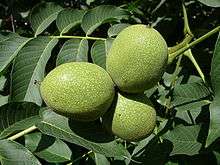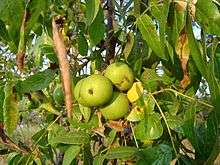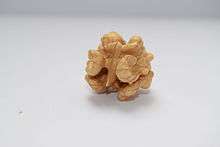Walnut

A walnut is the nut of any tree of the genus Juglans (Family Juglandaceae), particularly the Persian or English walnut, Juglans regia. Technically a walnut is the seed of a drupe or drupaceous nut, and thus not a true botanical nut. It is used for food after being processed while green for pickled walnuts or after full ripening for its nutmeat. Nutmeat of the eastern black walnut from the Juglans nigra is less commercially available, as are butternut nutmeats from Juglans cinerea. The walnut is nutrient-dense with protein and essential fatty acids.

Characteristics



Walnuts are rounded, single-seeded stone fruits of the walnut tree commonly used for the meat after fully ripening. Following full ripening, the removal of the husk reveals the wrinkly walnut shell, which is usually commercially found in two segments (three-segment shells can also form). During the ripening process, the husk will become brittle and the shell hard. The shell encloses the kernel or meat, which is usually made up of two halves separated by a partition. The seed kernels – commonly available as shelled walnuts – are enclosed in a brown seed coat which contains antioxidants. The antioxidants protect the oil-rich seed from atmospheric oxygen, thereby preventing rancidity.[1]
Walnuts are late to grow leaves, typically not until more than halfway through the spring. They secrete chemicals into the soil to prevent competing vegetation from growing. Because of this, flowers or vegetable gardens should not be planted close to them.
Types
The two most common major species of walnuts are grown for their seeds – the Persian or English walnut and the black walnut. The English walnut (J. regia) originated in Persia, and the black walnut (J. nigra) is native to eastern North America. The black walnut is of high flavor, but due to its hard shell and poor hulling characteristics it is not grown commercially for nut production. Numerous walnut cultivars have been developed commercially, which are nearly all hybrids of the English walnut.[2]
Other species include J. californica, the California black walnut (often used as a root stock for commercial breeding of J. regia), J. cinerea (butternuts), and J. major, the Arizona walnut. Other sources list J. californica californica as native to southern California, and Juglans californica hindsii, or just J. hindsii, as native to northern California; in at least one case these are given as "geographic variants" instead of subspecies (Botanica).
Production
| Rank | Country | Production (millions of tonnes) |
|---|---|---|
| 1 | | |
| 2 | | |
| 3 | | |
| 4 | | |
| 5 | | |
| — | | |
In 2013, worldwide production of walnuts was 3.458 million tonnes, with China contributing 49% of the world total (table).[3] Other major producers were (in the order of decreasing harvest): Iran, United States, Turkey and Ukraine.
The average worldwide walnut yield was about 3.5 tonnes per hectare in 2013.[3] Eastern European countries had the highest yield, with Slovenia and Romania each harvesting about 22 tonnes per hectare.[3]
The United States is the world's largest exporter of walnuts, followed by Turkey.[4] The Central Valley of California produces 99 percent of United States commercial English walnuts.[5]
Storage
Walnuts, like other tree nuts, must be processed and stored properly. Poor storage makes walnuts susceptible to insect and fungal mold infestations; the latter produces aflatoxin – a potent carcinogen. A mold-infested walnut batch should be entirely discarded.[1]
The ideal temperature for longest possible storage of walnuts is in the −3 to 0 °C (27 to 32 °F) and low humidity – for industrial and home storage. However, such refrigeration technologies are unavailable in developing countries where walnuts are produced in large quantities; there, walnuts are best stored below 25 °C (77 °F) and low humidity. Temperatures above 30 °C (86 °F), and humidities above 70 percent can lead to rapid and high spoilage losses. Above 75 percent humidity threshold, fungal molds that release dangerous aflatoxin can form.[1][6]
Food use
Walnut meats are available in two forms; in their shells or shelled. The meats can be as large as halves or any smaller portions that may happen during processing, candied or as an ingredient in other foodstuffs. Pickled walnuts that are the whole fruit can be savory or sweet depending on the preserving solution. Walnut butters can be homemade or purchased in both raw and roasted forms. All walnuts can be eaten on their own (raw, toasted or pickled) or as part of a mix such as muesli, or as an ingredient of a dish. For example, walnut pie is prepared using walnuts as a main ingredient. Walnut Whip, coffee and walnut cake, and pickled walnuts are more examples. Walnuts are also popular in brownie recipes and as ice cream toppings.
Walnut oil is available commercially and is chiefly used as a food ingredient particularly in salad dressings. It has a low smoke point, which limits its use for frying.[7][8]
Walnut is the main ingredient of Fesenjan, a khoresh (stew) in Iranian cuisine.
Nutritional value
 Walnut kernel, halves | |
| Nutritional value per 100 grams | |
|---|---|
| Energy | 2,738 kJ (654 kcal) |
|
13.71 | |
| Starch | 0.06 |
| Sugars | 2.61 |
| Dietary fiber | 6.7 |
|
65.21 | |
| Saturated | 6.126 |
| Monounsaturated | 8.933 |
| Polyunsaturated | 47.174 |
|
15.23 | |
| Vitamins | |
| Vitamin A equiv. |
(0%) 1 μg (0%) 12 μg9 μg |
| Vitamin A | 20 IU |
| Thiamine (B1) |
(30%) 0.341 mg |
| Riboflavin (B2) |
(13%) 0.15 mg |
| Niacin (B3) |
(8%) 1.125 mg |
| Pantothenic acid (B5) |
(11%) 0.570 mg |
| Vitamin B6 |
(41%) 0.537 mg |
| Folate (B9) |
(25%) 98 μg |
| Vitamin B12 |
(0%) 0 μg |
| Vitamin C |
(2%) 1.3 mg |
| Vitamin E |
(5%) 0.7 mg |
| Vitamin K |
(3%) 2.7 μg |
| Minerals | |
| Calcium |
(10%) 98 mg |
| Iron |
(22%) 2.91 mg |
| Magnesium |
(45%) 158 mg |
| Manganese |
(163%) 3.414 mg |
| Phosphorus |
(49%) 346 mg |
| Potassium |
(9%) 441 mg |
| Sodium |
(0%) 2 mg |
| Zinc |
(33%) 3.09 mg |
| Other constituents | |
| Water | 4.07 g |
|
| |
| |
|
Percentages are roughly approximated using US recommendations for adults. Source: USDA Nutrient Database | |
Walnuts without shells are 4% water, 15% protein, 65% fat, and 14% carbohydrates, including 7% dietary fiber (table).
In a 100 gram serving, walnuts provide 2,740 kilojoules (654 kcal) and rich content (more than 19% of the Daily Value or DV) of several dietary minerals, particularly manganese at 163% DV, and B vitamins (table).
While English walnuts are the most commonly consumed, their nutrient density and profile are generally similar to those of black walnuts.[9][10]
Unlike most nuts that are high in monounsaturated fatty acids, walnut oil is composed largely of polyunsaturated fatty acids (72% of total fats), particularly alpha-linolenic acid (14%) and linoleic acid (58%), although it does contain oleic acid as 13% of total fats.[9]
Health claims
Having evaluated the scientific literature on the potential health value of consuming walnuts, the US Food and Drug Administration (FDA) provided guidance described as a Qualified Health Claim to manufacturers for labeling of food and dietary supplement products, stating: "Supportive but not conclusive research shows that eating 1.5 ounces per day of walnuts, as part of a low saturated fat and low cholesterol diet and not resulting in increased caloric intake, may reduce the risk of coronary heart disease."[11]
One manufacturer of walnut products received an FDA Warning Letter for making unsubstantiated claims in the prevention, mitigation, and treatment of disease, causing the products to be misbranded as "drugs", and so violating regulations of the Federal Food, Drug, and Cosmetic Act in Title 21 of the US Code of Federal Regulations.[12]
Non-food applications
Folk medicine
Walnuts have been listed as one of the 38 substances used to prepare Bach flower remedies,[13] a kind of traditional medicine promoted for its possible effect on health. However, according to Cancer Research UK, "there is no scientific evidence to prove that flower remedies can control, cure or prevent any type of disease, including cancer".[14]
Inks and dyes
The husks of the black walnut Juglans nigra were once used to make an ink for writing and drawing, having been used by artists including Leonardo da Vinci and Rembrandt.[15]
Walnut husk pigments are used as a brown dye for fabric[16] as once applied in classical Rome and medieval Europe for dyeing hair.[17]
Cleaning
The United States Army once used ground walnut shells for the cleaning of aviation parts because of low cost and non-abrasive qualities. However, an investigation of a fatal Boeing CH-47 Chinook helicopter crash (September 11, 1982, in Mannheim, Germany) revealed that walnut grit clogged an oil port, leading to the accident and the discontinuation of walnut shells as a cleaning agent.[18]
Chemical analysis
Walnut hulls contain polyphenols that stain hands and can cause skin irritation. Seven phenolic compounds, including ferulic acid, vanillic acid, coumaric acid, syringic acid, myricetin, juglone, were identified in walnut husks. Juglone, the predominant phenolic, was found in concentrations of 2-4% fresh weight.[19]
Walnuts also contain the ellagitannin pedunculagin.[20] Regiolone has been isolated with juglone, betulinic acid and sitosterol from the stem bark of J. regia.[21]
Uses in Chinese culture
In China, pairs of walnuts have traditionally been rotated and played with in the palm of the hand, both as a means to stimulate blood circulation and as a status symbol. Individual and pairs of large, old, symmetrically shaped, and sometimes intricately carved walnuts are valued highly and have recently been used as an investment, with some of them fetching tens of thousands of dollars.[22] Pairs of walnuts are sometimes sold in their green husks for a form of gambling known as du he tao.[23]
Cultivars
See also
References
- 1 2 3 "Walnut; Agriculture - Transport Information Service". Association for German Insurance. 2010.
- ↑ "Commodity Profile: English Walnuts" (PDF). AgMRC, University of California. 2006.
- 1 2 3 4 "Production of Walnut with shell by countries; Browse data, World, 2013". UN Food & Agriculture Organization, Statistics Division (FAOSTAT). 2013. Retrieved 29 September 2016.
- ↑ "Major Exporting Countries of Walnuts, 2014". Agri Exchange. 2015. Retrieved 29 September 2016.
- ↑ "California Walnut Industry". California Walnut Board. 2016. Retrieved 29 September 2016.
- ↑ "Food, Nutrition & Agriculture - Prevention of aflatoxin". FAO, United Nations. 1998.
- ↑ "Walnut oil recipes". BBC. Retrieved 3 July 2014.
- ↑ Turner, Lisa. "Oil Change". Better Nutrition. Retrieved 5 July 2014.
- 1 2 "Nutrition facts: Nuts, walnuts, English dried per 100 g". Condé Nast. Retrieved 4 July 2014.
- ↑ "Nutrition facts: Nuts, walnuts, black, dried per 100 g". Condé Nast. Retrieved 4 July 2014.
- ↑ "Qualified Claims About Cardiovascular Disease Risk: Walnuts & Heart Disease Docket No. 02P-0292". US Food and Drug Administration,. 9 March 2004. Retrieved 1 November 2016.
- ↑ Wagner, Roberta (22 February 2010). "FDA Warning Letter to Diamond Food, Inc.". US Food and Drug Administration, Inspections, Compliance, Enforcement, and Criminal Investigations. Retrieved 1 November 2016.
- ↑ D. S. Vohra (1 June 2004). Bach Flower Remedies: A Comprehensive Study. B. Jain Publishers. p. 3. ISBN 978-81-7021-271-3. Retrieved 2 September 2013.
- ↑ "Flower remedies". Cancer Research UK. 26 January 2015. Retrieved 1 September 2013.
- ↑ "Black Walnut Ink Workshop". Guild of Natural Science Illustrators. October 2002. Retrieved 3 July 2014.
- ↑ "The Colors of Invention – How to Dye Fibers Naturally". Smithsonian Museum. November 13–16, 1997. Retrieved 3 July 2014.
- ↑ Sherrow, Victoria (2006). Encyclopedia of Hair: A Cultural History. Greenwood Publishing Group. pp. 267, 355. ISBN 9780313331459. Retrieved 3 July 2014.
- ↑ "In Re Air Crash Disaster at Mannheim Germany on 9/11/82. Ursula J. Schoenborn, As Executrix of the Estate of Leonedward Schoenborn, Deceased, v. the Boeing Company. Appeal of the Boeing Company. United States Court of Appeals, Third Circuit. 769 F.2d 115". Justia. 1985. Retrieved 10 April 2014.
- ↑ Cosmulescu, Sina Niculina; Trandafir, Ion; Achim, Gheorghe; Botu, Mihai; Baciu, Adrian; Gruia, Marius (15 June 2010). "Phenolics of Green Husk in Mature Walnut Fruits". Notulae Botanicae Horti Agrobotanici Cluj-Napoca. 38 (1): 53–56. doi:10.15835/nbha3814624. ISSN 1842-4309. Retrieved 11 October 2016.
- ↑ Metabolism of Antioxidant and Chemopreventive Ellagitannins from Strawberries, Raspberries, Walnuts, and Oak-Aged Wine in Humans: Identification of Biomarkers and Individual Variability. Begoña Cerdá, Francisco A. Tomás-Barberán, and Juan Carlos Espín, J. Agric. Food Chem., 2005, 53 (2), pages 227–235, doi:10.1021/jf049144d
- ↑ (−)-Regiolone, an α-tetralone from Juglans regia: structure, stereochemistry and conformation. Sunil K. Talapatra, Bimala Karmacharya, Shambhu C. De and Bani Talapatra, Phytochemistry, Volume 27, Issue 12, 1988, pages 3929–3932, doi:10.1016/0031-9422(88)83047-4
- ↑ "Status-conscious investors shell out on great walnuts of China". Reuters. Aug 28, 2012.
- ↑ "Game of clones". Global Times. 16 October 2012.
- ↑ Le Verger Francais tomme II Chapitre I Fruits Locaux & Regionaux 1948
- ↑ http://www.google.com/patents/USPP21718
- 1 2 Le Verger Francais, Tome 1 catalogue descriptif des Fruits adoptes 1947
- ↑ The Walnut Germplasm Collection of the University of California, Davis report No. 13 july 1994
Further reading
- Ramos, David D. (1997). Walnut Production Manual. UCANR. ISBN 978-1-879906-27-3.
- Smith, Jane S. (2009). The Garden of Invention Luther Burbank and the Business of Breeding Plants. Penguin Books. ISBN 978-0143116899.
External links
| Wikimedia Commons has media related to Walnuts. |
- Walnut at the Encyclopedia of Life
